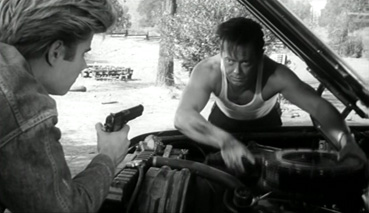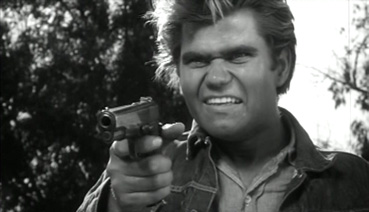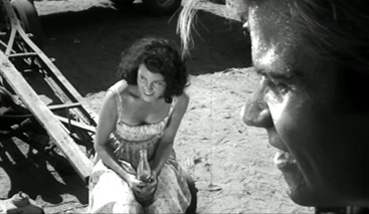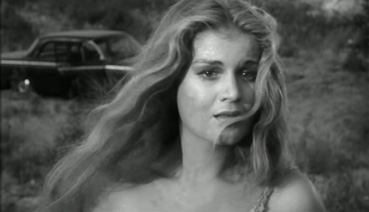|
It's genuinely hard to describe the jolt you get from an unprepared first viewing of The Sadist, the low budget debut feature by one James Landis. It's partly the content, but the real smack to the senses comes from the knowledge that it was released back in 1963. It's thus not that it goes places that American exploitation thrillers fear to tread, at least by today's standards, it's that it did so at a time when such territory is generally thought to be cinematically uncharted. You could argue that you're forewarned to some degree by the title (which frankly is nowhere near as cool as the original proposal, 12:01), although that production year does tend to soften the threat that word carries, suggesting a Hammer-esque tale of camp cruelty that may prove enjoyable largely for its provincial period quaintness. Which is not what you get, not by a long chalk.
It all starts when a car carrying teachers Ed, Doris and the older Carl pulls in to an isolated service station. It's a sunny day and the trio of friends are on their way to a baseball game, but the car has a broken fuel pump and if they can just get it fixed then they could still make the first pitch. The problem is that there's no sign of the station's owner, despite evidence that someone was there just a few minutes earlier. Keen to get on their way, Ed reasons that there must be a compatible part in one of the many wrecked cars that litter the area and sets to work removing one, figuring they'll settle up with the owner when he reappears. Except he doesn't. Someone else does. Someone very, very bad.

This brief and economical set-up oozes subtle intrigue and increasingly unsettling atmosphere, and quickly and effectively introduces us to its three hapless protagonists, a group we engage with due to a trio of unforced performances (none of the cast are professional actors) and the easy, everyday nature of their dialogue. With the connection made, Landis then ups the empathy engagement considerably when the three find themselves at the mercy of young sociopath Charlie Tibbs and his girlfriend Judy. Charlie has a gun and an attitude and is looking for transport, so is keen for Ed to continue with his fuel pump transplant. Ed's not about to argue. Charlie doesn't like schoolteachers, you see. Then again, it seems that Charlie doesn't like anyone much except Julie, whom he dotes on. Julie is a girl of few words, but she clearly thinks everything Charlie does is a blast and Charlie is all too happy to impress the lady, no matter what the cost to his newly acquired hostages.
Astonishingly, the ordeal that unfolds lasts for the entire remaining 80 minutes and plays out in unwaveringly tense real time. The make or break factor of this structural strategy has to be Charlie himself. As played by untrained newcomer Arch Hall Jr., this is a sometimes wildly over-the-top and leery performance, and yet there's something genuinely, psychotically and troublingly real about it – the act Hall puts on for the camera is exactly the one that Charlie would stage for his own audience, a show of dangerous madness by a genuinely dangerous madman, one designed to impress the girl and intimidate the hell out of everyone else. If you buy into this – and there's no earthly reason why you shouldn't – then Charlie becomes a hair trigger of wild unpredictability, in whose company you will be allowed to live only as long as it amuses him let you do so and who might blow your face off on nothing more than a whim.
The threat represented by Charlie is established early on and with jarring brutality, when Carl is pistol whipped for protesting after the group's baseball tickets are torn up, an act that symbolically cancels their chance of ever making it to the game. But this, as they say, is small potatoes. It's not long before Charlie provides a more graphic demonstration of his complete disregard for the suffering of others and the sanctity of life, a sequence that builds agonisingly to a moment of genuinely shocking violence (one in which you think you see more than you do, it should be pointed out). The effect, like the exploding head at the start of Cronenberg's Scanners, is to imprint firmly on the mind of the audience just what COULD happen, a threat that hangs menacingly over every subsequent scene. Unlike the mother-dominated Norman Bates of Psycho or the sexually repressed Mark of Peeping Tom, Charlie is a monster without cause or motivation, a completely amoral and conscience-free symbol of the dark side of rebellious youth, or at least the public fear of how it could manifest itself. It's surely no chance thing that a trio of teachers, representatives of establishment, education and self-discipline, are made to suffer at his hands.

Whether the decision not to let Judy speak out loud really was, as claimed in the commentary, the result of director Landis's uncertainty regarding Marilyn Manning's ability to deliver dialogue convincingly may have to remain forever unconfirmed, but if true then it's one of the happiest accidents in 60s cinema. In her gum-chewing silence she seems somehow even more morally bankrupt than Charlie, sipping playfully on a soda as a man pleads for his life and giggling like a delighted schoolgirl at Charlie's every malevolent act. It's her amusement at his behaviour that fans a fire she deliberately feeds, with Charlie's actions often prompted by her ideas for further cruelty whispered enthusiastically into his all-too receptive ear. You may deplore the very thought of violence against women, but I can almost guarantee that at more than one point during the film you'll want to hit her.
To reveal any more about how the story unfolds would be to rob the film of some of it's nerve-wracking unpredictability, something it retains right up to its theologically symbolic final scene. Take no comfort from the film's year of origin – expectations forged by contemporary works are repeatedly shattered, and in its story development, characters and narrative structure, it's a good ten years or more ahead of its closest companion pieces. It's influence on the indie horrors of the 70s is clear – there are elements here recognisable in The Texas Chainsaw Massacre, The Hills Have Eyes and Death Weekend to name but three – while as the first film (allegedly) based on true-life serial killers Charles Starkweather and Caril Fugate, it foreshadows both Terence Mallick's Badlands and Oliver Stone's Natural Born Killers. You can even trace a path through the wrong-turn thrillers of the 90s (Red Rock West, U-Turn, etc.), through works as diverse as Kalifornia and Funny Games, right through to the much maligned torture porn thrillers of recent years. Sit down with a pad and pencil for a couple of viewings and you should be able to draw up an even longer list of your own.

Given all this, perhaps the biggest surprise of The Sadist is that it has effectively remained under the critical radar for so long, although in the UK this might have something to do with its BBFC ban, which was only lifted for its uncut video release in 1999. It's appearance on UK DVD is, for me, a genuine revelation, a film that by all rights I should have seen years ago and been reading about since I was old enough to get wound up by fright cinema. And despite its low budget and first-film status, this is one smartly made movie, with Landis's waste-free direction and fellow feature first-timer Vilmos Zsigmond's consistently excellent cinematography – the use of deep focus, claustrophobic close-ups and mobile camera are particularly impressive, especially given the tight shooting schedule – both key elements in the film's sustained air of menace and screw-tightening tension. Seen in the context of when it was made, The Sadist is an extraordinary work that was years ahead of its time, one that for better or worse pointed the way to the extended-peril horror-thrillers of today. But it's also one that still stands alongside the best of them, in its tension, its cinematic economy, in the ruthlessness of its killers and its sympathetic victims, and in its ability to still startle and disturb an audience over forty years after it was made.
Restored in the US by AllDay Entertainment from an imperfect print, there are a number of good and not-so-good points to contend with here. In its favour is that the print is for the most part reasonably clean, the contrast very good and the detail not at all bad, but there are also a number of fine scratches visible and a small but sometimes very noticeable pair of almost three-dimensional bubbles that hang around for some time, like damage to a screen on which the film is being projected. Odd frames are missing here and there, and there is a dust increase and the odd jump at reel changes (the reel change markers are still present). Given the film's low budget origins and the likely difficulty in locating a better quality print or negative, I can live with all this.
For UK viewers there are an additional couple of issues to deal with, however. The AllDay Collector's Edition disc from which this transfer appears to have been sourced was framed non-anamorphic 1.66:1, presumably the original aspect ratio, but in the trip across the pond it has been cropped at the top and bottom slightly to 1.76:1, presumably to better fill that widescreen TV frame. Although not a drastic trim, it's still a slightly annoying and unnecessary one – I don't have the AllDay disc (and given that it was released back in 1998 I'm unlikely to bag a copy now), but direct comparisons with screen grabs on US review sites clearly show the lost picture information. In addition, the transfer here is an NTSC to PAL conversion, resulting in a softening of fine detail and some minor but detectable judders on fast motion or camera moves. It's still pretty good, I have to say, but some way from perfect.

The mono 2.0 soundtrack has the expected restrictions on dynamic range, but is otherwise surprisingly clear and clean of obvious damage, despite some audible crackle in places. There is some variance on dialogue volume in the early stages, but this sounds more like re-recording on the filmmaker's part than any fault with the transfer. The same is probably true for the distortion on the radio broadcast in the final scene.
Vilmos Zsigmond commentary
The only port over from the AllDay disc is a good one. The regally named author Stuart Galbraith IV proves a damned good feed man, prompting a range of fascinating stories from the heavily accented and award-winning Hungarian cinematographer, who recalls the difficulty of shooting a film based outdoors that is supposed to be taking place at midday in real time (hence that original title) and provides some nice technical background on the planning of shots, the lenses used, and the process of 'flashing' film, as well as detail on the performers, the director and the location. Galbraith also uses the opportunity to probe Zsigmond on his early days in the industry, his friendship with countryman and fellow cinematographer Laszlo Kovacs, and his Oscar-winning work on Close Encounters of the Third Kind. There are a couple of gaps, but on the whole this is enthralling stuff.
A compromise disc in which the pluses outweigh the minuses. The picture cropping is unnecessary but minor, the NTSC to PAL transfer is frankly unsurprising given that this is being released by a small independent label, and the print damage is something we have to live with on both sides of the water. But the film itself is so striking, so damned unexpected, so influential and so gripping that I have no trouble recommending the disc nonetheless, especially given that AllDay's NTSC original has long since dropped out of sight.
|